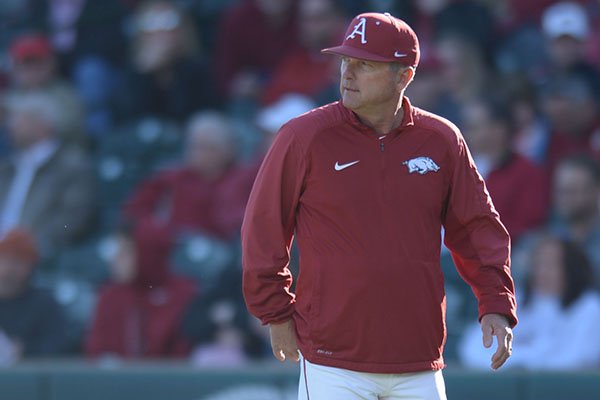LITTLE ROCK — Our soccer-playing kinfolk sidelined with injuries and their teammates playing keep away while leading big, the man one row behind hoped out loud that Arkansas’ baseball team could win the last three series of the season and earn a national seed.
He never elaborated, but the guess is he was thinking ahead to the Razorbacks hosting a Super Regional available to a top eight seed and had overlooked the fact that the number of national seeds was doubled last October to bring baseball in line with the format employed in the NCAA’s other 64-team events.
Leading the SEC West and a lock for one of the 16 seeds, Arkansas does not have to win all three series — at LSU and Georgia, and home vs. Texas A&M — to be in the top eight. Considering the high regard for SEC baseball, a division title will suffice, but Ole Miss, the Razorbacks’ closest pursuer, has series remaining against two teams below .500 in conference play and 11-10 South Carolina.
Truth is, neither hosting a Super Regional nor winning the SEC Tournament comes with guaranteed participation in the College World Series.
Last year, No. 2 national seed North Carolina, 5 seed Texas Tech and 8 seed Stanford did not make it past their home Regional, let alone to Omaha, and that attrition rate is about the norm.
After Florida won the 2017 national championship, somebody else researched how the eight seeds had fared since the format was introduced in 1999.
Surprisingly, 32 of the 152 seeds lost in the Regionals, ranging from two losses for No. 2 seeds to seven losses for No. 7 seeds. Thirty-four of the seeds lost in the Super Regionals, including three No. 1s and seven No. 5s.
In 19 years, only eight national seeds have won the CWS and all were top five seeds, including two each at No. 2 and No. 3. Last year, No. 1 seed Oregon State was the only one of 293 NCAA teams with less than double-digit losses, but the Beavers lost two straight in Omaha.
With the SEC Tournament fast approaching, the lack of success by the national seeds prompted a look at how the winner in Hoover, Ala., has fared in the NCAA since the conference tournament was expanded from 10 teams to 12 in 2013:
—2013, LSU won in Hoover, but lost two straight in Omaha. Mississippi State, the No. 5 seed in Hoover, won three games by a total of five runs, lost to Vanderbilt 16-8, then bounced back to make the CWS finals.
—2014, LSU won the championship in Hoover, but was eliminated in the Regional. A No. 6 seed in Hoover, Vanderbilt was eliminated in the second round, but won the national championship. Ole Miss, a No. 2 seed in Hoover, was eliminated in the second game of the conference tournament, but also reached Omaha.
—2015, Florida won in Hoover and won three games in Omaha before being eliminated. Arkansas, LSU and Vanderbilt also reached the CWS. In Hoover, No. 5 seed Arkansas was 2-2, No. 1 seed LSU lost in the semifinals and No. 2 seed Vanderbilt lost in the finals.
—2016, No. 3 Texas A&M won in Hoover, then lost at home in the Super Regional. A No. 4 seed in Hoover, Florida lost in the finals, but qualified for Omaha.
—2017, No. 2 seed LSU won in Hoover and reached Omaha. Florida, the No. 1 seed in Hoover, lost in the conference tournament, but beat LSU two straight for the national championship. Texas A&M, the seventh seed in the conference tournament, also made it to Omaha.
SEC coaches would never say so, but I wonder how many would be satisfied to play a couple of games in Hoover and return home to get the pitching rotation in order for the double-elimination Regional.

